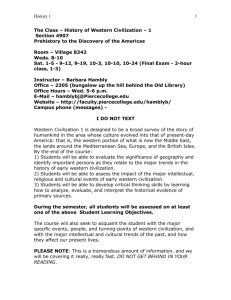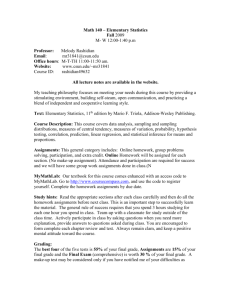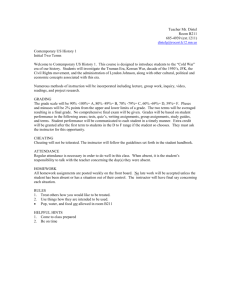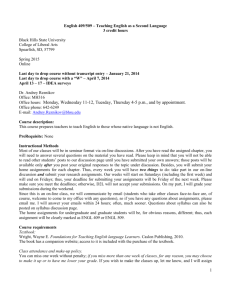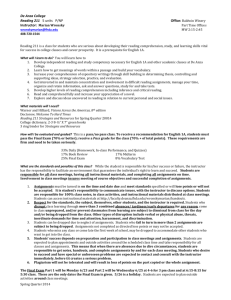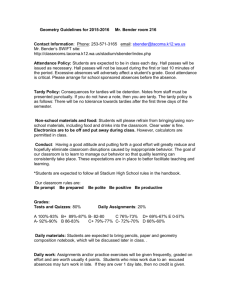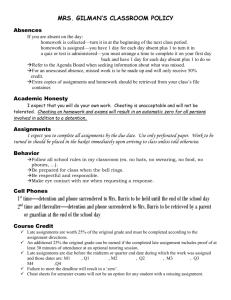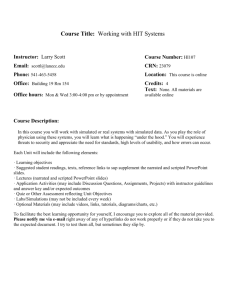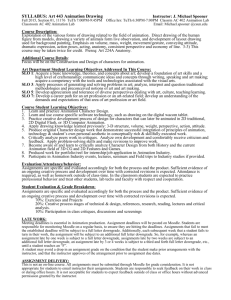ART 230 Syllabus (Doc)
advertisement
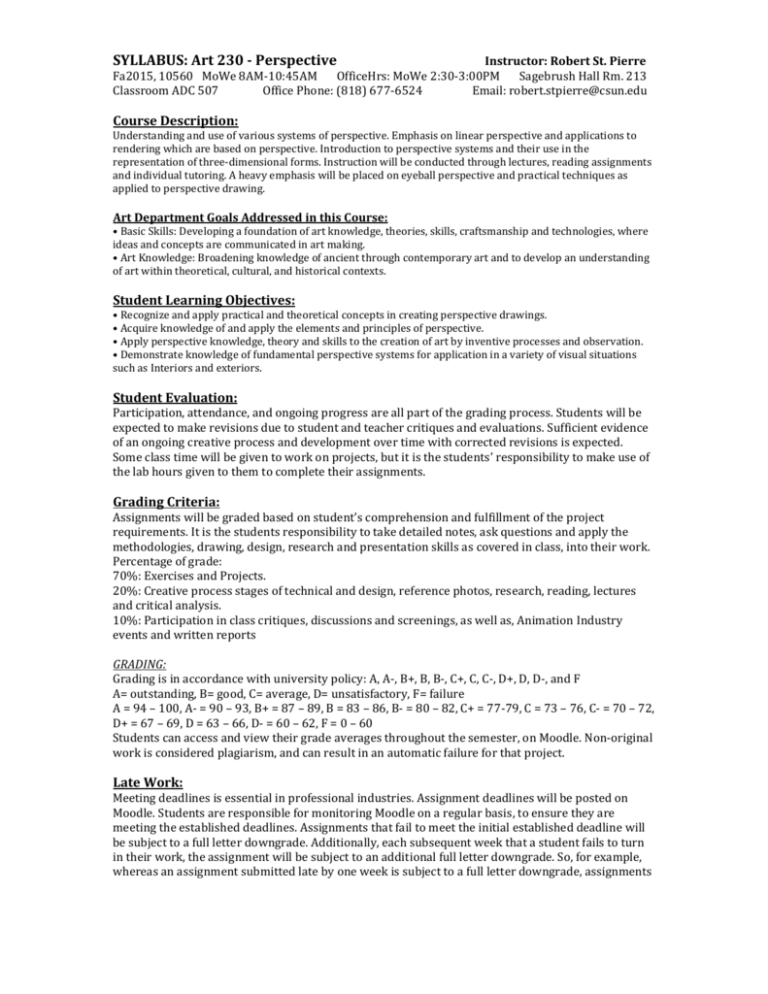
SYLLABUS: Art 230 - Perspective Instructor: Robert St. Pierre Fa2015, 10560 MoWe 8AM-10:45AM OfficeHrs: MoWe 2:30-3:00PM Sagebrush Hall Rm. 213 Classroom ADC 507 Office Phone: (818) 677-6524 Email: robert.stpierre@csun.edu Course Description: Understanding and use of various systems of perspective. Emphasis on linear perspective and applications to rendering which are based on perspective. Introduction to perspective systems and their use in the representation of three-dimensional forms. Instruction will be conducted through lectures, reading assignments and individual tutoring. A heavy emphasis will be placed on eyeball perspective and practical techniques as applied to perspective drawing. Art Department Goals Addressed in this Course: • Basic Skills: Developing a foundation of art knowledge, theories, skills, craftsmanship and technologies, where ideas and concepts are communicated in art making. • Art Knowledge: Broadening knowledge of ancient through contemporary art and to develop an understanding of art within theoretical, cultural, and historical contexts. Student Learning Objectives: • Recognize and apply practical and theoretical concepts in creating perspective drawings. • Acquire knowledge of and apply the elements and principles of perspective. • Apply perspective knowledge, theory and skills to the creation of art by inventive processes and observation. • Demonstrate knowledge of fundamental perspective systems for application in a variety of visual situations such as Interiors and exteriors. Student Evaluation: Participation, attendance, and ongoing progress are all part of the grading process. Students will be expected to make revisions due to student and teacher critiques and evaluations. Sufficient evidence of an ongoing creative process and development over time with corrected revisions is expected. Some class time will be given to work on projects, but it is the students’ responsibility to make use of the lab hours given to them to complete their assignments. Grading Criteria: Assignments will be graded based on student’s comprehension and fulfillment of the project requirements. It is the students responsibility to take detailed notes, ask questions and apply the methodologies, drawing, design, research and presentation skills as covered in class, into their work. Percentage of grade: 70%: Exercises and Projects. 20%: Creative process stages of technical and design, reference photos, research, reading, lectures and critical analysis. 10%: Participation in class critiques, discussions and screenings, as well as, Animation Industry events and written reports GRADING: Grading is in accordance with university policy: A, A-, B+, B, B-, C+, C, C-, D+, D, D-, and F A= outstanding, B= good, C= average, D= unsatisfactory, F= failure A = 94 – 100, A- = 90 – 93, B+ = 87 – 89, B = 83 – 86, B- = 80 – 82, C+ = 77-79, C = 73 – 76, C- = 70 – 72, D+ = 67 – 69, D = 63 – 66, D- = 60 – 62, F = 0 – 60 Students can access and view their grade averages throughout the semester, on Moodle. Non-original work is considered plagiarism, and can result in an automatic failure for that project. Late Work: Meeting deadlines is essential in professional industries. Assignment deadlines will be posted on Moodle. Students are responsible for monitoring Moodle on a regular basis, to ensure they are meeting the established deadlines. Assignments that fail to meet the initial established deadline will be subject to a full letter downgrade. Additionally, each subsequent week that a student fails to turn in their work, the assignment will be subject to an additional full letter downgrade. So, for example, whereas an assignment submitted late by one week is subject to a full letter downgrade, assignments late by two weeks are subject to an additional full letter downgrade, and assignments late by 3 or 4 weeks are subject to a third and forth full letter downgrade, etc., until a student reaches an “F”. A student may avoid a drop in an assignment grade on the condition that the student make prior arrangements with the instructor, and that the instructor approves of the arrangement prior to assignment due dates. Assignment Delivery: All assignments must be submitted through Moodle for grade consideration. Please upload only JPEG images to Moodle. PSD or any other files are not acceptable forms of file submissions. Students who elect to work traditionally may do so, however all artwork must be digitally scanned and composited then uploaded to Moodle as a JPEG submission. It is not appropriate for students to email instructor their assignments. Students are responsible to seek feedback on their work in class or during office hours. It is not acceptable for students to expect feedback outside of class or office hours without advanced permission granted by the instructor. End of Term: A digital copy of all assignments must be submitted at the end of the semester and in formats specified by the Instructor and/or Animation Area Coordinator for Assessment purposes. Failure to deliver a complete DVD can negatively impact final grade. DVD’s will not be returned to the student. Attendance Policy: Attendance is required. This studio course requires attendance, actual work in class and at least 3 hours of homework/lab time outside of class time each week. Attendance will be taken at the beginning of each class. Students who are not present when roll is called are personally responsible for informing the instructor of their presence and will be marked as tardy. Please see the CSUN student handbook for allowable class tardiness and absences. Students are responsible for contacting the instructor, prior to a scheduled class, if for whatever reason they anticipate being late or absent from class. More than three non-excused absences will result in an automatic lowering of the student’s final semester grade by at least one full grade level. • Three absences are allowed without penalty. More than three absences will result in a lower final course grade. •Each absence over the allowed three absences will lower the course grade by a letter grade. For example: An “A” course grade with four absences will result in a “B” course grade. • A doctor’s note will not excuse absences beyond the three allowed. If illness results in excessive absences, a medical withdrawal from the course is recommended. • Two late arrivals and/or early departures of more than 15 minutes will be counted as one absence. Missed Class Policy Lectures and demonstrations will not be repeated. Students who miss a class are responsible to contact another student in the class for missed information. Office Hours: Students are strongly encouraged to attend office hours. Students who wish to schedule time to visit during office hours are encouraged to do so by booking through the Art Advisement Center located in AC100, or by calling (818) 677-2348 to make arrangements and an appointment with the Professor. Student Behavior/Professional Deportment: In the classroom/lab, students are expected to practice professional behavior and treat other students, lab techs and faculty with respect and cooperation. Academic dishonesty is a serious offense for which a student may be expelled, suspended or awarded a failing grade to an assignment or the entire course. Academic dishonesty includes cheating, fabrication, facilitating academic dishonesty and plagiarism. A student found to be committing academic dishonesty would be reported to the Office of the Vice President for Student Affairs. The student code of conduct can be found on page 586 of the University Catalog or on the CSUN website: http://www.csun.edu/studentaffairs/pdfs/standards_student_conduct.pdf Classroom Rules: • Cell phones must be turned off or put on vibrate. Phone talking or texting in class is not allowed. • No headphones allowed. • Using your laptop to work on anything outside of this course during class time is not permitted. • You are welcome to bring food and drinks into class. However make sure that all drink containers have a tight fitting, spill proof lid. Keep all food items and drinks away from art work at all times. Special Needs: Students with disabilities must register with the Center on Disabilities and complete a service agreement each semester. Staff with in the Center will verify the existence of a disability based on the documentation provided and approved accommodations. Students who are approved for test-taking accommodations must provide an Alternative Testing Form to their faculty member signed by a counselor in the Center on Disabilities prior to making testing arrangements. The Center on Disabilities is located in Bayramian Hall, room 110. Staff can be reached at 818 677-2684. Required Supplies: • If students opt to work digitally, then students must bring their own laptop to class equipped with Photoshop or a similar graphics program. It is strongly recommended that students who opt to work digitally also bring a portable graphics tablet such as a Wacom or Bamboo, or similar. • Students who elect to work traditionally are required to bring the following materials: (Please note: Drafting supplies must be brought to every class) Drafting tools: 18” minimum ruler 10” triangles: 45-45 and 30-60 degree, not with beveled edges 24” minimum metal T-square Two Mechanical pencils: 0.5 mm Mechanical pencils lead: H and 2H Fine Point Sharpie or other permanent marker Tracing paper or vellum: 18-inch roll or 18 x 24 inch pad: white only Drawing paper pad 18 x 24 inch (not newsprint) Strathmore 400 series Sketch pad 9 x 12 inch One 8 x 11 inch page holders (clear only, not non-glare) Erasers: kneaded and white vinyl Drafting tape Required Text Book: Architectural Graphics, by Francis D.K.Ching, John Wiley& Sons, Inc., ISBN 0-471-20906-6 Please Note: This syllabus is subject to change due to overall student progress, or judgment calls from the Instructor.



